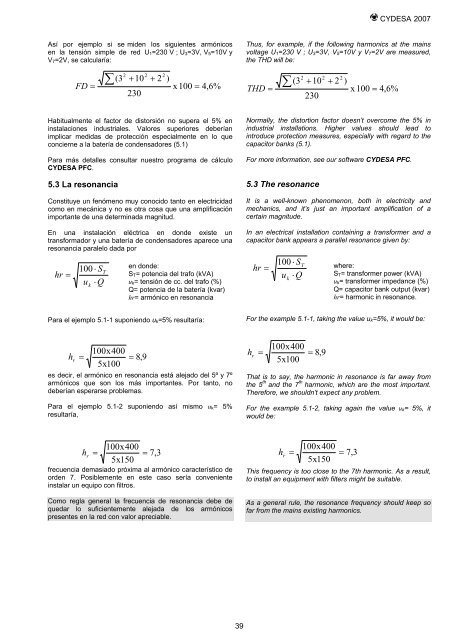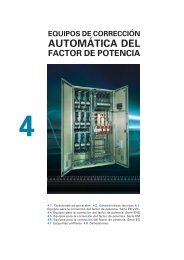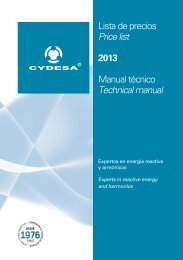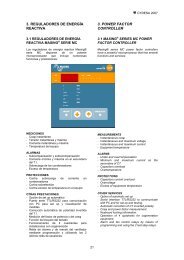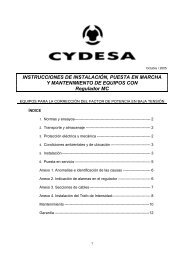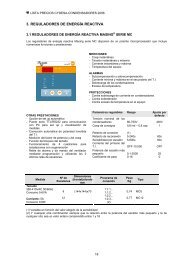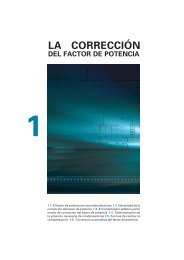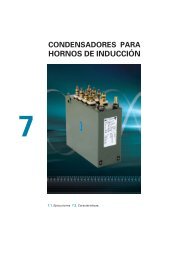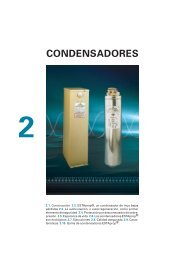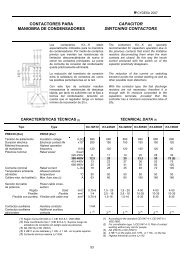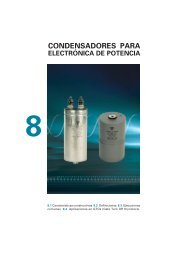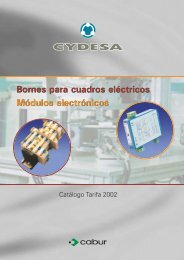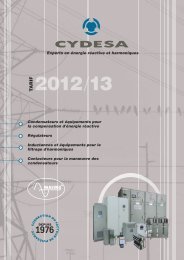Descarga el catálogo 2007 (pdf) - Cydesa
Descarga el catálogo 2007 (pdf) - Cydesa
Descarga el catálogo 2007 (pdf) - Cydesa
- No tags were found...
You also want an ePaper? Increase the reach of your titles
YUMPU automatically turns print PDFs into web optimized ePapers that Google loves.
CYDESA <strong>2007</strong>Así por ejemplo si se miden los siguientes armónicosen la tensión simple de red U 1=230 V ; U 3=3V, V 5=10V yV 7=2V, se calcularía:FD (32Г102302Г 22)x 100 4,6%Thus, for example, if the following harmonics at the mainsvoltage U 1=230 V ; U 3=3V, V 5=10V y V 7=2V are measured,the THD will be:THD (32Г1023022Г 2 )x 100 4,6%Habitualmente <strong>el</strong> factor de distorsión no supera <strong>el</strong> 5% eninstalaciones industriales. Valores superiores deberíanimplicar medidas de protección especialmente en lo queconcierne a la batería de condensadores (5.1)Para más detalles consultar nuestro programa de cálculoCYDESA PFC.5.3 La resonanciaConstituye un fenómeno muy conocido tanto en <strong>el</strong>ectricidadcomo en mecánica y no es otra cosa que una amplificaciónimportante de una determinada magnitud.En una instalación <strong>el</strong>éctrica en donde existe untransformador y una batería de condensadores aparece unaresonancia paral<strong>el</strong>o dada porhrukb Sb QTen donde:S T= potencia d<strong>el</strong> trafo (kVA)u k= tensión de cc. d<strong>el</strong> trafo (%)Q= potencia de la batería (kvar)hr= armónico en resonanciaNormally, the distortion factor doesn’t overcome the 5% inindustrial installations. Higher values should lead tointroduce protection measures, especially with regard to thecapacitor banks (5.1).For more information, see our software CYDESA PFC.5.3 The resonanceIt is a w<strong>el</strong>l-known phenomenon, both in <strong>el</strong>ectricity andmechanics, and it’s just an important amplification of acertain magnitude.In an <strong>el</strong>ectrical installation containing a transformer and acapacitor bank appears a parall<strong>el</strong> resonance given by:hrukb Sb QTwhere:S T= transformer power (kVA)u k= transformer impedance (%)Q= capacitor bank output (kvar)hr= harmonic in resonance. 100 9 100 3Para <strong>el</strong> ejemplo 5.1-1 suponiendo u k=5% resultaría:For the example 5.1-1, taking the value u k=5%, it would be:hr100x4005x100 8,es decir, <strong>el</strong> armónico en resonancia está alejado d<strong>el</strong> 5º y 7ºarmónicos que son los más importantes. Por tanto, nodeberían esperarse problemas.Para <strong>el</strong> ejemplo 5.1-2 suponiendo así mismo u k= 5%resultaría,hr100x4005x100 8,9That is to say, the harmonic in resonance is far away fromthe 5 th and the 7 th harmonic, which are the most important.Therefore, we shouldn’t expect any problem.For the example 5.1-2, taking again the value u k= 5%, itwould be:hr100x4005x150 7,3frecuencia demasiado próxima al armónico característico deorden 7. Posiblemente en este caso sería convenienteinstalar un equipo con filtros.Como regla general la frecuencia de resonancia debe dequedar lo suficientemente alejada de los armónicospresentes en la red con valor apreciable.hr100x4005x150 7,This frequency is too close to the 7th harmonic. As a result,to install an equipment with filters might be suitable.As a general rule, the resonance frequency should keep sofar from the mains existing harmonics.39


